
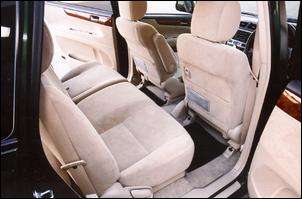
Toyota's newly released Avensis Verso range represents a new breed of people movers. It's not a full size vehicle, rather it's a versatile 5-seater wagon with the extra seating for two when required; it's the perfect vehicle for blended and extended families. What's more, it's all kept within the length and width boundaries of a Toyota Camry...
Nowhere is the Avensis Verso more impressive than its seating and cargo flexibility.
The Avensis is a 7-seater with three rows of seats - twin bucket seats at the front, a three-seater centre row and a two-seater third row. Each seating position is comfortable, though the third row seat is clearly more suited for children. In this rearmost pew, head and feet room is relatively limited and access is via a relatively gymnastic climb through from the second row; the 60/40 split second row seat slides and folds out of the way with a simple one-step action.
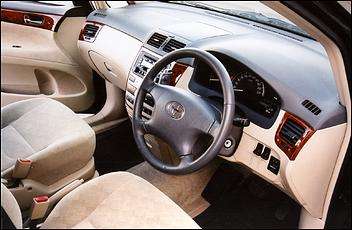
The second row seat is much more comfortable and spacious than the third. It's easy to get cosy using the adjustable angle backrest, fore-aft sliding base and fold down centre armrest. Headroom is generous, though foot space under the front seat cushion is a bit squeezie. Note that child seat anchorages are integrated into the second row backrests, but not the third.
Up front, the Avensis accommodates with twin bucket seats featuring individual fold down centre armrests. These armrests are set very close to the side of your body, while the handbrake lever is located very near to the side of the drivers set - the upshot is there's just enough space for walk-through access to the rear.
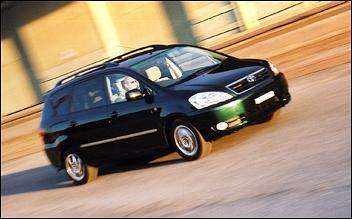
Standard equipment onboard the Avensis extends to twin front airbags, front seatbelt pre-tensioners and force limiters with adjustable anchorages, adjustable head restraints in all seating positions except the second row centre, remote central locking (with immobiliser) and auto-up power windows in the front and second rows - the rear side windows are fixed.
Also standard is twin air conditioning, which sees controls for the secondary rear system built into the roof above the second row right-side passenger. Ventilation outlets are incorporated into the roof for second and third row passengers.
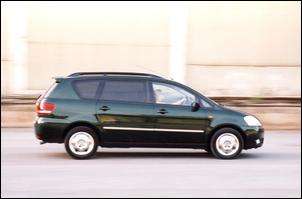
The top-of-the-line Ultima model - as tested - adds four more airbags (in the A-pillars and the outer side of the front seats), a tasteful splashing of woodgrain, a leather bound steering wheel and a 3-in-1 double-DIN single CD/cassette/tuner. Wired to four full-range door speakers and front tweeters, the system offers good sound quality at normal listening levels. Oddly, though, there's a huge difference in switchgear feel between the audio system and the air conditioning/ventilation controls.
With the Avensis arranged as a 7-seater - with the third row seat in use - the rear cargo area is a bit tight in length. Beneath the flip-up cargo floor, however, you'll find a handy 132-litre storage bin, which is the perfect place to stow semi long-term luggage such as umbrellas and a travel rug. The spare wheel - which would otherwise be placed beneath the cargo floor - is located on the undercarriage beneath the front passenger seat.
Other features of the rear cargo area include a courtesy light, a 120W 12V power socket, storage compartment for the jack and tool kit and a relocatable cargo blind. The hatch lifts high enough so most people won't bump their head.
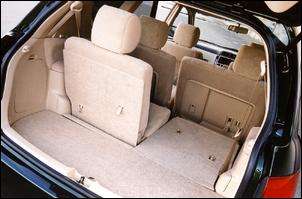
When the need for more cargo area is required - and you need seating for only five or six people - the 50/50 split third row backrest can be separately folded forward. Just lift the rear hatch, slide out the third row head restraint(s), pull the tab on the backrest and it'll fold forward perfectly flush with the cargo area floor. Once removed, you can store the headrests in the aforementioned under-floor bin.
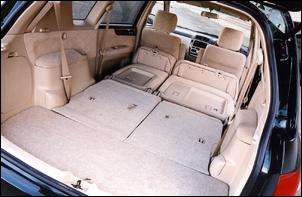 When you need to transport an even larger cargo
volume, the Avensis easily transforms into a 'panel van'. Once the third
row seats have been folded forward, simply flip the bottom cushion of the
second row into its leading edge, remove its headrests and fold the
backrest forward. This creates a truly mammoth, perfectly flat cargo floor
- also ideal for an overnight camp.
When you need to transport an even larger cargo
volume, the Avensis easily transforms into a 'panel van'. Once the third
row seats have been folded forward, simply flip the bottom cushion of the
second row into its leading edge, remove its headrests and fold the
backrest forward. This creates a truly mammoth, perfectly flat cargo floor
- also ideal for an overnight camp.
Aside from its obvious cargo swallowing potential, the Avensis offers plenty of day-to-day knickknack storage. Up front there're large door pockets, a generous glovebox, a storage bin above the audio system and to the right of the steering column, coin holders and twin cup holders. There is no centre console.
Second row passengers get side ashtrays, door pockets, front backrest pouches and a total of four cup holders, while the third row people get two cup holders and side storage bins.
Another intelligent feature is the flip-down hook on the back of the driver's seat - this is perfect to suspend grocery bags (of up to 4 kilograms) when you can't be bothered opening the hatch.
Toyota should be congratulated for their incredible space utilisation on the Avensis - remember, all of this has been built into a vehicle that's narrower and shorter than a Camry.
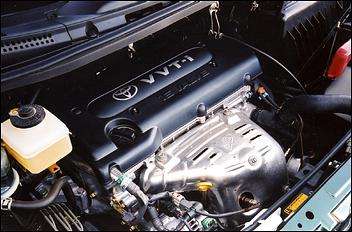
The Avensis' motor gets the job done - but only just. Under its stubby bonnet is a 1AZ-FE 2-litre transverse all-alloy four featuring DOHC, 16-valves and Toyota's flaunted VVT-i variable inlet cam timing system (operating over a 50-degree range). Running a 9.8:1 compression ratio and drinking normal unleaded fuel, the 1AZ motor is rated at 110kW at 6000 rpm and 192Nm at 4000 rpm. Certainly, these peak power and torque figures are achieved at quite high rpm for a 2-litre engine that has to lug around a considerable 1490 kilogram kerb mass. The clever VVT-i system, however, gives it a very even torque spread that isn't told by the raw data.
Despite its torque spread, however, the Avensis' four is nowhere near as smooth or refined as a modern six cylinder - the availability of a V6 in the comparable Honda Odyssey is a major advantage in this upper-level medium-size van category.
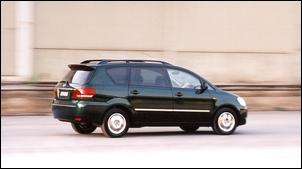
The Ultima model comes equipped with a 4-speed automatic transmission driving the front wheels. Teamed with the 2-litre engine, the automatic trannie is quick to adapt to driving style and - when the throttle's floored - is happy to let the engine spin to its 6400 redline. Not that the engine sounds very happy while doing it...
The gear selector sprouts from the steering column and moves up and down with the adjustment of the steering wheel angle. Our only criticism is the selector gets very close to your left knee when you engage a low gear and it feels very sloppy. The overdrive button is also obscured from view behind the steering wheel and takes a while to find.
Straight-line acceleration in the Avensis automatic is pretty borderline - 0 - 100 km/h runs stretch to over 12-seconds, meaning you don't merge onto a highway unless there's plenty of space.
Its fuel consumption performance, however, is slightly more impressive. We averaged around 10-litres per 100 kilometres over a wide variety of driving conditions - not bad for a near-1500kg automatic people mover. Fuel consumption on the open road is undoubtedly aided by the Avensis' slippery 0.30Cd.
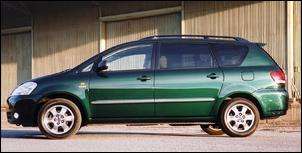
Unlike many larger family-oriented vehicles, the Avensis has quite responsive steering at the straight-ahead position - there's only a moderate amount of slackness before the wheels decide to point in the direction you're steering them. Steering weight - using a power-assisted rack-and-pinion arrangement - is relatively light.
The brakes, too, are impressive. Unlike any other vehicle in its class, the Avensis features a brake assist function, which gives increased braking performance in emergency situations. When the computer-controlled system detects a rapid, firm brake application, it automatically maximises the hydraulic pressure going to the brakes to give the shortest possible stopping distance.
The more passé braking system details include ABS, EBD and four-wheel disc brakes (which are ventilated at the front). Even though the front brakes of our test car had been warped - we're told after being thrashed on the racetrack - the Avensis displayed strong stopping power.
The ride is typical of many people movers - there's a noticeable jiggle when unladen, but add two or three passengers and/or some luggage and the firmness disappears.
The Avensis uses MacPherson struts with L-shaped lower arms and a swaybar at the front and, at the rear, a trailing arm torsion beam axle, with toe-correcting bushes and a swaybar. As you might expect, it will understeer when pushed through a tight corner, but on the open road it corners very well, soaking up bumps with generous suspension travel and remaining completely composed at all times.
Unlike the big brother Tarago, the Avensis is quite easy to drive on a daily basis - it's manoeuvrable (with a 5.5-metre turning radius), the hinged doors open nice and wide, there's excellent visibility and everything's easy to operate. If you're stepping up from a conventional sedan or wagon, the Avensis won't cause any headaches.
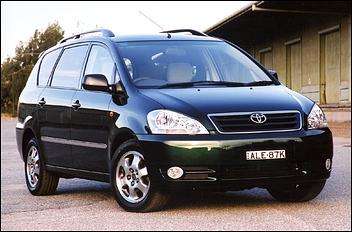
One-box van designs usually have pretty limited visual appeal, but the Avensis bucks this tradition with some sharp styling. The design focuses on the image of a low centre of gravity, the front end is sleek - with aggressive multi-reflector headlights - while the rear is stylishly rounded and accentuated by swoopy taillights.
Standard on the Ultima are six-spoke 16 x 6.5-inch alloy wheels with 205/60 Dunlop Sport 300s, a rear spoiler (incorporating a LED brake light), front fog lights and sturdy roof rails. Heavily tinted 'privacy glass' features on the second and third row side windows and the hatch - though curiously, not the front row.
Within its category of 4-cylinder 7-seater people movers, the new Toyota is quite expensive. Retailing for $46,900 (plus ORCs and an optional navigation system) the top-line Ultima demands $5000 more than the base GLX automatic Avensis.
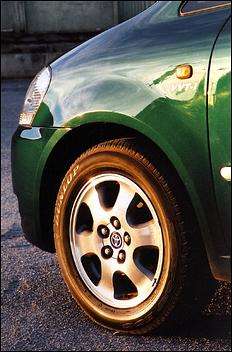
In comparison, vehicles such as the Holden Zafira, Kia Carens and Mitsubishi Nimbus undercut the Ultima by a substantial margin - by $23,000 to $6,000. The only competitor that's dearer than the Avensis is the Honda Odyssey - the 4-cylinder version of which costs around $48,000, while the top-line V6 and leather-lined version checks in at about $54,000.
Unlike the many cheaper alternatives, however, the Avensis is exceptionally well built. Interior fabrics and materials are brilliant and their fitment and operation is faultless. Paint quality is also top-notch.
The only quality shortcomings are the lack of trim covers for the vanity mirrors and slight panel margin variation. Our test car also had an intermitted rattle from the driver's A-pillar. These small gripes aside, the Avensis is a hard vehicle to nitpick - a bit more power and torque would be the only things we'd wish for.
As it is, however - if you can afford it - the Avensis Ultima is perhaps the best 4-cylinder medium size people mover. But we'd suggest looking elsewhere for the best value...
|
Toyota Avensis Verso Ultima Fast
Facts...
|
